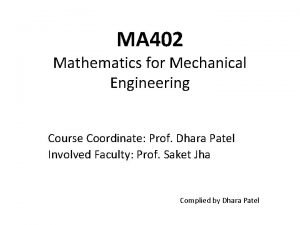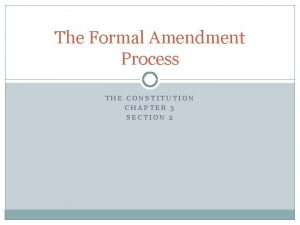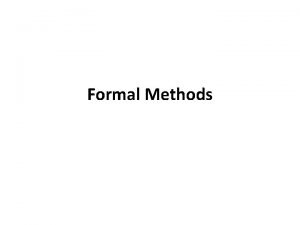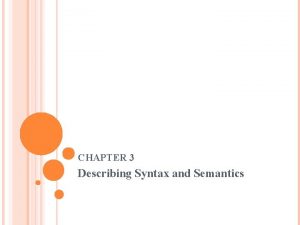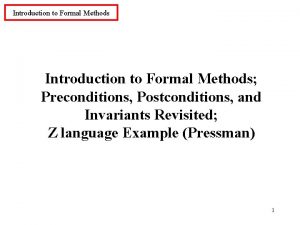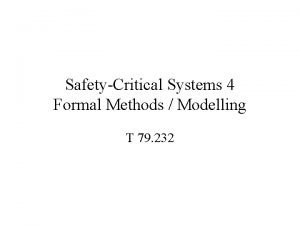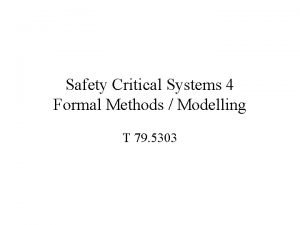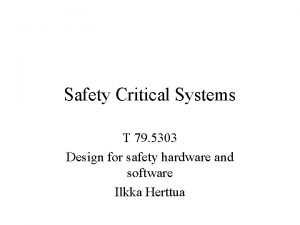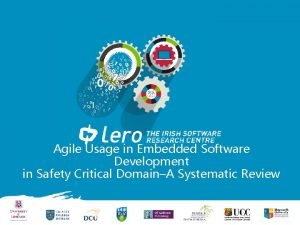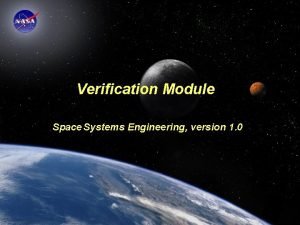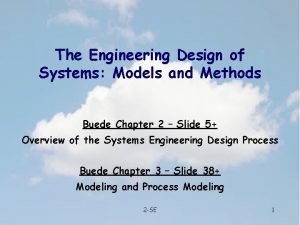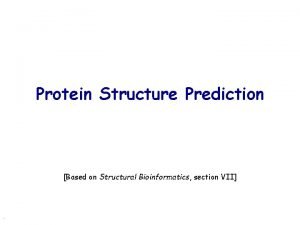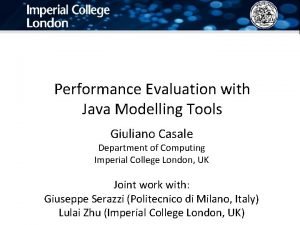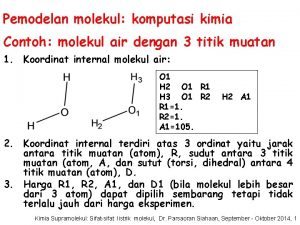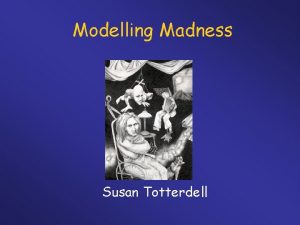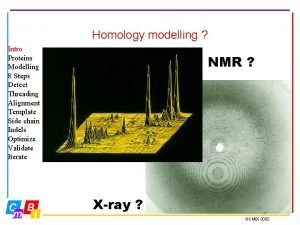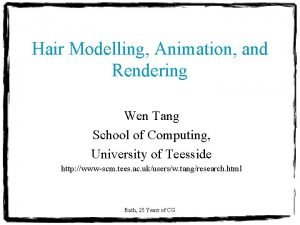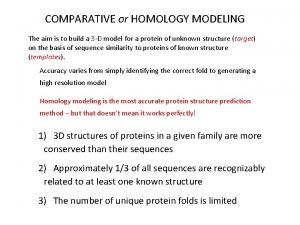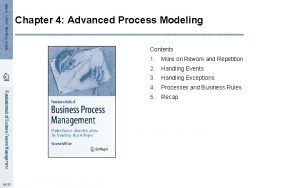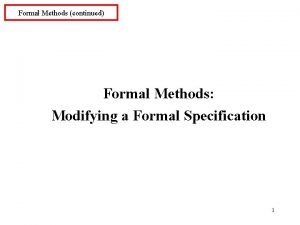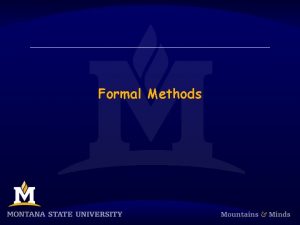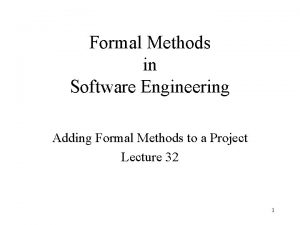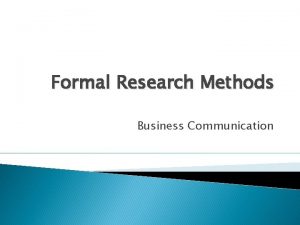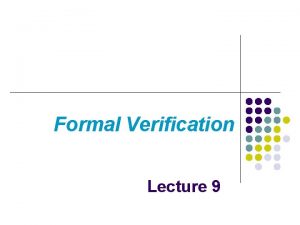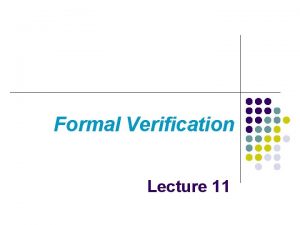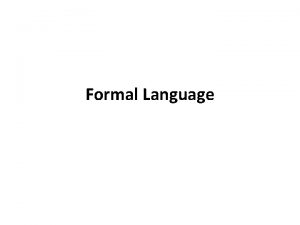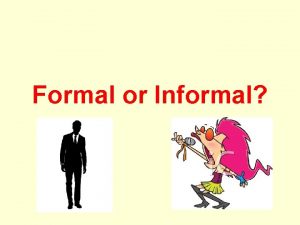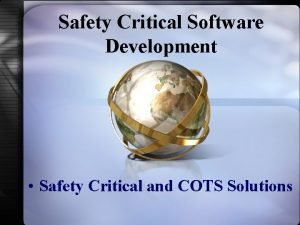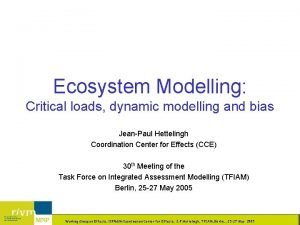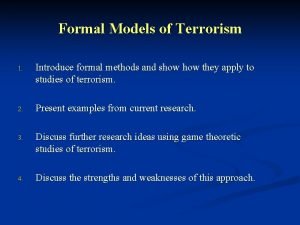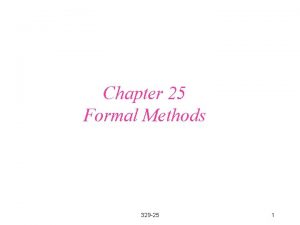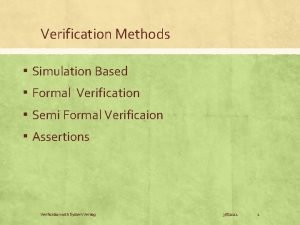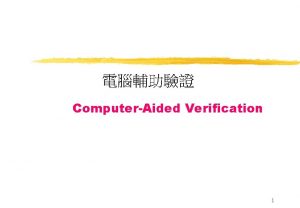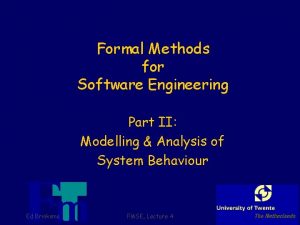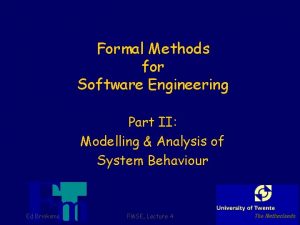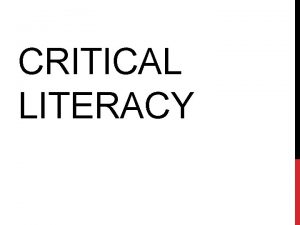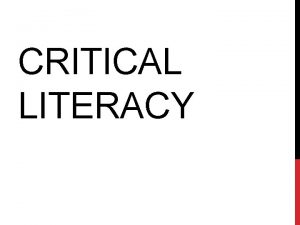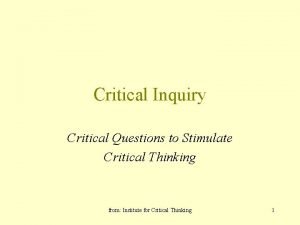Safety Critical Systems 4 Formal Methods Modelling T

































- Slides: 33

Safety Critical Systems 4 Formal Methods / Modelling T 79. 5303

Formal Methods Formal methods have been used for safety and securitycritical purposes during last decades for e. g: - Certifying the Darlington Nuclear Generating Station plant shutdown system. - Designing the software to reduce train separation in the Paris Metro. - Developing a collision avoidance system for United States airspace. - Assuring safety in the development of programmable logic controllers. - Developing a water level monitoring system. - Developing an air traffic control system.


Need for Formal Methods • To mathematically describe the system – both software and hardware/functionality • To mathematically describe the properties for validation/verification – possiblity to prove • Enables simulation ( validation) • Enables automatic verification


Formal Methods and Safety-Critical Systems 1. Formal Methods are used in expressing requirements, design and analysis of a safety critical software and hardware. The use of mathematical techniques reduce possible personal interpretation 2. There exists a need for using formal methods from writing requirements to verifying the system that they are fulfilling those 3. Many difficulties are related to misunderstanding requirements/specification. 4.

Semi-formal Requirements/Specification 1. Requirements should be unambiguous, complete, consistent and correct. 2. Natural language has the interpretation possibility. More accurate description needed. 3. Using pure mathematic notation – not always suitable for communication with domain expert. 4. Formalised Methods are used to tackle the requirement engineering. (Structured text, formalised English).

Domain Expert(s) Validation Text Informal Verification Consistency Model Formal Verification (Testing) Implement. Consistency (another) Model Consistency

Method (system engineering) consists of: 1) Underlying model of development (process) 2) Language (expressing formal specification) 3) Defined, ordered steps (phases) 4) Guidance for applying steps in a coherent manner (instructions)

Formal Methods/ Model orientated 1. These languages involve the explicit specification of a state model - system‘s desired behaviour with abstract mathematical objects as sets, relations and functions. 2. VDM (Vienna Development Method ISO standardised). 3. Z-language 4. B-Method

Formal Methods/ Property orientated include axiomatic and algebraic methods. - Axiomatic use first order predicate logic to express pre/post conditions over abstract data types (Larch/ADA, Sternol) - Algebraic methods are based on multi and order sorted algebras and relate properties of the system to equations over entities of the algebra (Act One, Clear and OBJ).

Formal Methods/Process orientated 1. Process algebras have been developed to meet the needs of concurrent systems. 2. Theories behind Hoare‘s Communicating Sequential Processes (CSP) and Milner‘s Calculus of Communicating Systems (CCS). 3. Protocol specification language LOTOS is based on combination of Act One and CCS.

Formal Language/Method selection criteria Good expressiveness Core of the language will seldom or never be modified after its initial development, it is important that the notation fulfils this criterion. Established/accepted to use with Safety Critical Systems Possibility of defining subset/coding rules to allow efficient automatic processing by tools. Support for modular specifications – basic support is expected to be needed. Temporal expressiveness Tool availability

Formal Methods/ Z-language bases on first order predicate logic and set theory. - - The specification expressed in Z-notation is divided into smaller parts – schemas These schemas describe the statical and dynamical characteristics of the system: static: possible states, invariants dynamic: possible operations, pre/post states Z is an excellent tool for modelling data, state and operations

Simple example of Z notation ___Birthday. Book_______ known: PNAME birthday: NAME → DATE ___________ known = dom birthday ___________ ___Add. Birthday____ ∆Birthday. Book name? : NAME date? : DATE ___________ name? /€ known birthday’ =birthday. U{name? →date? } ___________ ___Find. Birthday______ ΞBirthday. Book name? : NAME date!: DATE _____________ name? € known date! = birthday(name? ) _____________ ___Remind________ Ξ Birthday. Book today? : DATE cards!: PNAME _____________ cards!={n: known|birthday(n)=today? } _____________

Formal Methods/ B-method 1. B is quite well-known. Although not as established as Z, B figures in some remarkable success stories of industrial applications of formal methods, e. g. by MATRA and B Toolkit/UK. 2. B-method uses Abstract Machine Notation (AMN) for specification and implementation.

Formal Methods/ B-method 1. Like Z, B is based on set theory and provides a rich set of operations. 2. B includes facilities for modular specifications, although not as powerful as those of Z. 3. The temporal expressiveness of B is poor. Only relations between a state and the next can be expressed.

Modelling Requirements • Models needed for communication with domain experts (simulation) • Automatic verification (model checker, theorem proving)

Some Modeling Styles versus Decomposition: Functional Object-based versus View point: Black Box Glass Box Representation: Blabla GFHP Textual versus Graphical

Verification and Validation - Verification – Are we building the system right? - Validation – Are we building the right system?

Verified software process

Model Verification e. g. „A point may never move when a route is locked. “ Requirements Modeling Language Challenger Domain Expert Proof Verification Requirements. Support Tool Model Verifier e. g. challenger is false in the following case: • User: set route A • System: steer point 1 left • HW: point 1 at left • User: set point 1 right • System: steer point 1 right CONFLICT!!!

Languages of Logic – Propositional Logic Statements – (1 st Order) Predicate Logic (FOPL) Statements quantified ( , ) over things (objects!) – Linear Temporal Logic (LTL) Statements quantified ( , , G, F, H, P) over things and time – Computational Tree Logic (CTL) Statements quantified ( , , G, F, H, P, , ) over things, time and worlds (modal logic) – Enhanced Regular Expression Logic (ERE) Statements about occurrence patterns (seq, sel, itr, par) of events and conditions causing actions S S S t • Note: The list above is neither complete nor it does necessarily imply any hierarchy! t

(Some) Languages of Logic CT L ERE ? Time G, F, H, P Temporal Logic (LTL) Modal Logic Propositional Logic Worlds , DL Objects , Predicate Logic

Verification Technologies Model Checking Theorem Proving CT L ERE ? Time G, F, H, P Temporal Logic (LTL) Worlds , Modal Logic Proposition al Logic D L Objects , Predicate Logic

Tools for Validation & Verification • Tools for Validation – Static analysers derive implicit information about a model (or a program) • Examples: Ke. Y, VDMTools (IFAD), … – Simulators for executable specifications • Examples: UML (Cassandra), MATLAB/Simulink, Statemate, … • Tools for Verification – Model checkers for “brute force” enumeration of states • Examples: Alloy, SATO, SMV/Nu. SMV, SPIN, Statemate, UPPAAL, Validas, … – Theorem provers provide support for algebraic proofs of model properties • Examples: ACL 2, Alloy, e. CHECK (Prover Technologies), KIV, PVS (SRI Inc. ), TRIO-Matic, VSE II, …

Statemate modelling • • Based on Harel state charts from 80‘s Functional decomposition Used years in aviation and car industry Mainly for simulating and validating functionality (Test cases) • Model checker for verification

Language of Statemate Finite State Machines (FSM): E 1 S 1 A virtual machine that can be in any one of a set of finite states and whose next states and outputs are functions of input and the current state. S 2 E 2 “History Connector” Hierarchy: Structure: A state may consist of states which consists of states…. Priority Rule: Priority is given to the transition whose source and target states have a higher common ancestor state. S 12_S 3 S 1 E 3 S 2 E 1 S 21 H S 22 E 2 S 1_S 2 Concurrency: “Processes that may execute in parallel on multiple processors or asynchronously on a single processor. ” IEEE 729 S 1 S 2 S 11 E 2 S 12 E 1 S 21 F 2 S 22 F 1

Functional Decomposition • Functional decomposition breaks down complex systems into a hierarchical structure of simpler parts. • Breaking a system into smaller parts enables users to understand, describe, and design complex systems. • Functional decomposition consists of the following steps: – Define the system context. – This will help define the system boundaries. – Describe the system in terms of high-level functions and their interfaces. – Refine the high-level functions and partition them into smaller, more specific functions.

Functional Decomposition External Data Source External Data Sink Hierarchy Level 0 („Context-Diagram“) Top-Down Hierarchy Level 1 Hierarchy Level 2 Bottom-Up Hierarchical Structured Activity Chart

System Development and Validation with STATEMATE closing the Loop via linear ‘Testbench Models’

System Validation: Generating Test-Data from Requirement Scenarios (Waveform Diagram derived from Trace-File) Operational Input Requirement 2 Requirement 1 Operational Input Operational Output

Formal Methods Home assignments: 11. 2 What problems are associated with specifications written in natural language? 11. 18 Explain what is meant by a 'schema' in Z, and describe its basic form. Please email to herttua @uic. asso. fr by 27 of March 2008 References: I-Logix, Know. Gravity, ITT
 Critical semi critical and non critical instruments
Critical semi critical and non critical instruments Spaulding classification system
Spaulding classification system Mathematical model of mechanical system
Mathematical model of mechanical system Mathematical modelling of mechanical systems examples
Mathematical modelling of mechanical systems examples Critical reading meaning
Critical reading meaning Direct and indirect wax pattern
Direct and indirect wax pattern Formal amendment process 4 methods
Formal amendment process 4 methods Vdm specification language
Vdm specification language Formal methods of describing syntax and semantics in ppl
Formal methods of describing syntax and semantics in ppl Z formal specification
Z formal specification Formal methods
Formal methods Formal methods
Formal methods Safety critical design
Safety critical design Safety critical items list
Safety critical items list Safety-critical hardware
Safety-critical hardware Agile embedded software development
Agile embedded software development Direct methods for sparse linear systems
Direct methods for sparse linear systems Effective methods for software and systems integration
Effective methods for software and systems integration Noaa
Noaa The engineering design of systems: models and methods
The engineering design of systems: models and methods What is technological modelling
What is technological modelling Homology modelling steps
Homology modelling steps Java modelling tools
Java modelling tools Molecular modelling laboratory
Molecular modelling laboratory Modelling madness what's new
Modelling madness what's new Models of interaction in hci
Models of interaction in hci Lbo model test
Lbo model test Which geometric modeling has ambiguous representation
Which geometric modeling has ambiguous representation Homology modelling steps
Homology modelling steps Hair modelling
Hair modelling Embedded product development company
Embedded product development company Homology modelling steps
Homology modelling steps Exercise 4
Exercise 4 Modelling rich interaction
Modelling rich interaction



